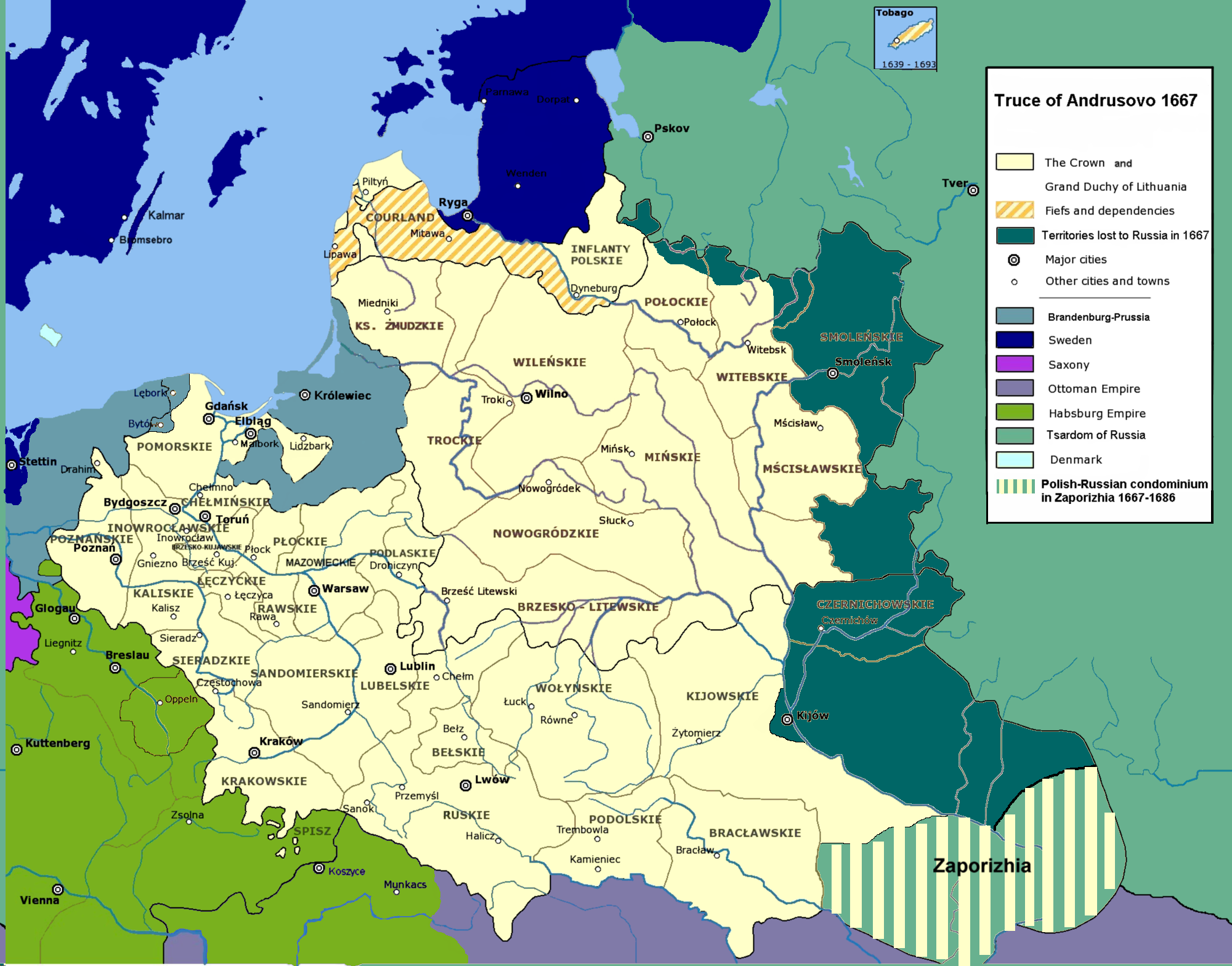Treaty Of Andrusiv on:
[Wikipedia]
[Google]
[Amazon]
 The Truce of Andrusovo ( pl, Rozejm w Andruszowie, russian: Андрусовское перемирие, ''Andrusovskoye Pieriemiriye'', also sometimes known as Treaty of Andrusovo) established a thirteen-and-a-half year
The Truce of Andrusovo ( pl, Rozejm w Andruszowie, russian: Андрусовское перемирие, ''Andrusovskoye Pieriemiriye'', also sometimes known as Treaty of Andrusovo) established a thirteen-and-a-half year
Scan of the treaty at IEG Mainz
{{Polish peace treaties Andrusovo Andruszow, Treaty of Poland–Russia relations Treaties of the Polish–Lithuanian Commonwealth Treaties of the Tsardom of Russia 1667 treaties 1667 in the Polish–Lithuanian Commonwealth 1667 in Russia 17th century in the Zaporozhian Host Bilateral treaties of Russia
truce
A ceasefire (also known as a truce or armistice), also spelled cease fire (the antonym of 'open fire'), is a temporary stoppage of a war in which each side agrees with the other to suspend aggressive actions. Ceasefires may be between state act ...
, signed in 1667 between the Tsardom of Russia and the Polish–Lithuanian Commonwealth, which had fought the Russo-Polish War since 1654 over the territories of modern-day Ukraine and Belarus.
Afanasy Ordin-Nashchokin (for Russia) and Jerzy Chlebowicz
Jerzy is the Polish version of the masculine given name George. The most common nickname for Jerzy is Jurek (), which may also be used as an official first name. Occasionally the nickname Jerzyk may be used, which means "swift" in Polish.
People
...
(for the Commonwealth) signed the truce on 30 January/9 February 1667 in the village of Andrusovo not far from Smolensk. Representatives of the Cossack Hetmanate were not allowed.
Terms
The Polish–Lithuanian Commonwealth and the Tsardom of Russia (Muscovy) agreed on the following terms: * A truce was signed for 13.5 years during which both states were obligated to prepare the conditions for eternal peace. * Russia secured the territories of Left-bank Ukraine, Siever lands, and Smolensk. * Poland-Lithuania was left with Right-bank Ukraine, and Russian-occupied Belarus with Vitebsk, Polotsk, and Dzwinsk. * The city ofKiev
Kyiv, also spelled Kiev, is the capital and most populous city of Ukraine. It is in north-central Ukraine along the Dnieper, Dnieper River. As of 1 January 2021, its population was 2,962,180, making Kyiv the List of European cities by populat ...
, though situated on the right bank of the Dnieper River, was handed over to Russia for two years under a series of conditions. The transfer, though phrased as temporary, was, in fact, a permanent one cemented in 1686 in exchange for 146,000 rubles.
* The Zaporizhzhia was recognized as a condominium
A condominium (or condo for short) is an ownership structure whereby a building is divided into several units that are each separately owned, surrounded by common areas that are jointly owned. The term can be applied to the building or complex ...
of both states.
* Both states agreed to provide a common defence against the Ottoman Empire.
* The right of free trade was granted.
* A compensation from Russia to Poland-Lithuania of 1,000,000 złotych or 200,000 rubles was agreed on for the lands of Left-bank Ukraine.
Consequences
The transfer of Kiev to the Russian tsardom had far-reaching consequences. Kiev, situated in the Greek-orthodox part of the Lithuanian Grand Duchy before the Union of Lublin (1569) and in the Polish kingdom thereafter, was the seat of the orthodox metropolitan, who, despite being formally placed under the Roman pope since the Union of Brest (1596), retained authority over the Orthodox population in Poland-Lithuania's eastern territories. Prior to Andrusovo, Kiev had been an orthodox counterweight to the Moscow patriarchate, founded in 1589, and since the metropolitanship of Petro Mohyla hosted the Mohyla Academy, that opened orthodoxy to Western influence. The transfer of Kiev to Russia came only days after patriarch Nikon, who reformed the rites within the Muscovite patriarchate, had won the upper hand over his adversary Avvakum, resulting in an intra-Russian schism ('' raskol'') between the Reformed Orthodoxy and theOld Believers
Old Believers or Old Ritualists, ''starovery'' or ''staroobryadtsy'' are Eastern Orthodox Christians who maintain the liturgical and ritual practices of the Russian Orthodox Church as they were before the reforms of Patriarch Nikon of Moscow bet ...
.
Kiev now supplied the Russian patriarch with an academy (after Mohyla's offer to found an academy in Moscow had been rejected) on whose scholars Nikon had relied already for his reforms. Nikon himself, having proposed to replace the Russian ''simfonia'' (the traditional balance of ecclesiastical and secular power) by a more theocratic model, was banned upon his success, effectively shifting the power balance to the Romanov tsars ruling Russia since the end of the Great Smuta (1613). As the see of the metropolitan, Kiev furthermore granted Moscow influence on the Orthodox population in Poland-Lithuania. "Protection" of the Orthodox population thus became a future argument for Romanov influence over eastern Poland-Lithuania.
Perspectives
In Ukraine, the treaty is often viewed as leading to the partition of the Hetmanate state between its more powerful neighboring states. From thePolish
Polish may refer to:
* Anything from or related to Poland, a country in Europe
* Polish language
* Poles, people from Poland or of Polish descent
* Polish chicken
*Polish brothers (Mark Polish and Michael Polish, born 1970), American twin screenwr ...
point of view the treaty is considered a significant mistake that tipped the balance of power in the region and replaced Poland as the dominant state by the emerging Russian Empire.Europe. A History. Norman Davies. London: Pimlico 1996, p. 556, 558
See also
*Khmelnytsky Uprising
The Khmelnytsky Uprising,; in Ukraine known as Khmelʹnychchyna or uk, повстання Богдана Хмельницького; lt, Chmelnickio sukilimas; Belarusian language, Belarusian: Паўстанне Багдана Хмяльніц ...
* The Ruin (Ukrainian history)#List of Treaties
References
External links
Scan of the treaty at IEG Mainz
{{Polish peace treaties Andrusovo Andruszow, Treaty of Poland–Russia relations Treaties of the Polish–Lithuanian Commonwealth Treaties of the Tsardom of Russia 1667 treaties 1667 in the Polish–Lithuanian Commonwealth 1667 in Russia 17th century in the Zaporozhian Host Bilateral treaties of Russia